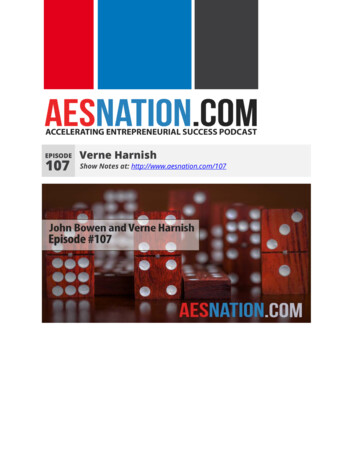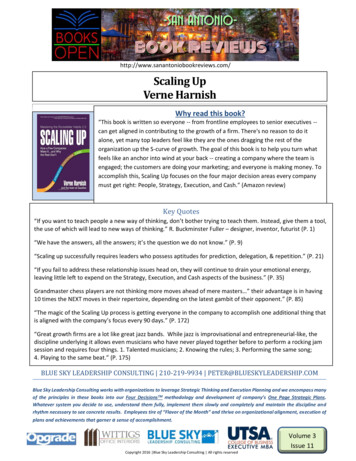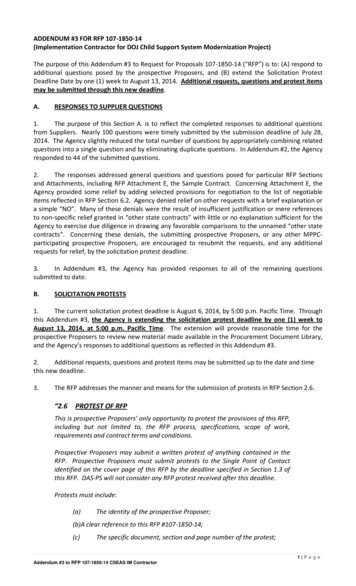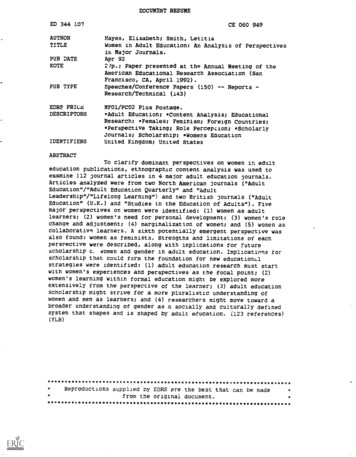
Transcription
EPISODE107Verne HarnishShow Notes at: http://www.aesnation.com/107
EPISODE107Verne HarnishShow Notes at: http://www.aesnation.com/107Dear Fellow Entrepreneur,We are thrilled that you have joined us here at AES Nation, where we’re dedicated to acceleratingentrepreneurial success—your success.We hope you find this transcript to be a valuable supplement to the podcast and encourage you to shareit with like-minded entrepreneurs in your network.In addition to our five-times-a-week interviews with leading entrepreneurs, keep in mind that we haveplenty of other resources to help put your success on the fast track: Our monthly live, interactive webinars co-hosted with Dan Sullivan of Strategic Coach featuretoday’s top entrepreneurs. These are world-changing entrepreneurs who have the insight to helptransform your business.Our virtual conferences showcase business leaders and experts in elevating your success andyour life. These one-day online events give you access to the in-depth presentations andinteraction that you’d get at a live conference from the comfort of your office or home.The AESNation.com weekly newsletter will always keep you on top of the latest interviews andevents. Sign up here.Thanks for being part of the AES Nation community. We’ll see you online.Best of success,John BowenCo-founder, AES NationPage 1 of 15
EPISODE107Verne HarnishShow Notes at: http://www.aesnation.com/107John Bowen: As entrepreneurs, we want to grow our business dramatically and I got aspecial treat for you today. I have the growth guy, Verne Harnish. Verne is an amazingindividual I've gotten to know pretty well and many of you already know him through his books.He's a best-selling author. His first real big hit was the Rockefeller Habits. It was all aboutgrowing your business and he didn't stop there. His new book, Scaling Up is just an amazingbook and just a tremendous resource, but in addition to that, he is acknowledged by his peers.First, he's built the community, the EO. Many of you know Entrepreneurial Organization andFortune has called him one of the Top 10 Best Minds in Small Business. If you are interested,and I know you are, if you're interested in growing your business, stay tuned. You do not wantto miss this.Verne, I am so excited to have you here today. You are just an amazing individual doingremarkable things to our fellow entrepreneurs, so thank you.Verne Harnish: John, glad to be with you here from sunny Barcelona and thank you so muchfor that kind introduction.John: You've done so much and we’re going to touch in just a little bit. The thing I love andit's really what we're doing here at AESnation.com is, your passion is helping fellowentrepreneurs be extremely successful and you walk the talk too because you've got somesuccessful businesses as well, but Verne, how did you get here? Most of us as entrepreneursdon't wake up and say, "Okay, I'm there, I'm going arrive." You've had a heck of a journey.Why don't you share that little background before we dive into how we're going to really createall this growth?Verne: Got it. I think like a lot of entrepreneurs, I grew up around entrepreneurs. Mygrandmother had upholstery shop. My grandfather had a TV repair business and my dad whowas in the space race back in Littleton, Colorado. He and a bunch of guys got together,founded a company called Higher Electronics and it was a rocket ship and so, had a chanceto kind of be around that the whole time I grew up, but he lost the business in the '73 recession.We lost everything, moved out from Colorado to Kinsley, Kansas, literally 25 miles the sideof Dodge City and he and I became janitors at a local nursing home.We did that for about six months and we said, "Look, we're going to go start up a littlebusiness," and he and I launched when I was fifteen, an appliance repair business for MarburnRyan at the local Sears Catalog store and I've been kind of on my own ever since.John: It's amazing how so many opportunities. We learn the entrepreneurship early. We don'tall do it that way, but many of us do it. What your passion has always been, Verne, is growingbusinesses and I don't think there's an entrepreneur who doesn't want to grow a business.Page 2 of 15
EPISODE107Verne HarnishShow Notes at: http://www.aesnation.com/107As Steve Job says, "Make a dent in the universe.” The difference is I don't know thatanybody's helped any more entrepreneurs than you have. How do you do that?Verne: I've been at it for thirty three years. I think part of it is just kind of picking a focus andstaying at it. Back in '83, co-founded ACE, Association of Collegiate Entrepreneurs and earlyparticipants were Michael Dell and Mark Cuban and we threw the big party for Steve Jobswhen he got fired from Apple. Then launched EO as you mentioned and it's global today ateleven thousand members and launched an executive program at MIT that I ran for fifteenyears and that's where I really learned the job.We moved about a thousand kind of crazedentrepreneurs.Brad Feld who went on to do Techstars, Ted Leonsis went on to be vice chairman of AOLand many, many, many other guys that have gone on to build billion-dollar companies andbecome billionaires. It's really at their feet that I kind of pull together the ideas that make uptoday, what we do at Gazelles and in the book Scaling Up.John: The title of the MIT program, was it Building Giants I think.Verne: Yeah, Birthing of Giants.John: Birthing of Giants, so if anyone is remotely questioning, not staying with us, building,birthing a giant and you've got all kinds of testimonials that you've done that, Verne. Let's gointo your new book. It's just an amazing book. I've shared with you, I've never seen as muchcontent and backup resources and thoughtfulness and process and proven results you getout of this and all for a nominal price of a book, so thank you.Verne: You're welcome.John: Now, one of the things I love and that you kind of break down different pieces. We'vegot a short podcast. We've got a lot of material on the book, but what I wanted to dive into aresome of the barriers of Scaling Up, because when I picked up the book, I mean I just look atit and see it right behind you here on the left, that Scaling Up. It's got that going up. I love thatand built a number of businesses and it's so much fun when you hit that at the curb, and youstart taking off. What are the barriers that are holding many of us back?Verne: What we saw in all of our research was that there are really fundamentally three, andthat was your own development if you want to 10x the company. You’ve got to 10x yourselfand 10x everybody else in the firm. Building scalable infrastructure so you can actually deliveron the ten million phones that you’re marketing and ends up generating on a Monday as theyhave at Apple. Then number three is this well-functioning marketing department separatefrom sales. What I thought, John, I’d love to give really practical things you can do tomorrow.Page 3 of 15
EPISODE107Verne HarnishShow Notes at: http://www.aesnation.com/107Let me just touch on one that might be helpful of the many that we share within the book. Onleadership development, I think what’s critical is for you to really get focused on everybodylearning and reading inside the company. Right now, Mark Zuckerberg said as a goal for2015, to read a book every two weeks. Mark Cuban reads three hours a day. We’d reallyencourage you to do something very simple. Start a book club, book of the month and geteverybody inside the company reading a dozen books this year or listening to them orwatching the videos as TED talks, however is your style, but on the leadership development,to get focused on it, twelve hours for the frontline, twenty four hours for mid management andsomewhere around forty eight to sixty hours for the senior team.On the scalable infrastructure, there, I think what’s critical is every entrepreneur absolutelyhas to find the right number two. That person where they can take their ideas and toss themover to trans them and this person can actually execute. We all need our team. In the book,we talk about how to find this number two and some of the things they need to do than tobuild a scalable infrastructure to support your vision. Then number three on the marketingside, I actually learned what I know about marketing from the same guy, Steve Jobs and Inteland Genentech which is Regis McKenna back in the early 80’s.He said really two things. He said, “Number one, marketing is all about this,” and he holds upa finger. It represented this one hour a week where you must have a separate marketingmeeting, even if it’s with yourself, separate from sales. What I want you to spend your timedoing is working on the 4Ps of marketing. Spend an hour every week and think about theproduct, the price, the place and their promotion, but let me update it. Have everyone outthere go out and Google “Ogilvy,” one of the top ad agencies in the world, “Ogilvy’s 4Es ofmarketing.”These 4E’s have replaced the 4Ps. They’ve got a white paper and a PowerPoint that you candownload and work through this for an hour every week and you’re going to be amazed athow that’s going to move your business forward. Keep learning. Find the right number twoand get out there and set up an hour a week and work through these 4Es and 4Ps ofmarketing.John: Verne, these are things that every one of us can execute. I just want to restate themjust one more time as the leadership, so many of us are almost accidental CEOs. We didn’treally start out with this. We got to bring our whole team along and boy, what resources thebooks can create and then have them learning that along with us. It’s just so available,creating kind of a learning group and the book club as you mentioned. The scalableinfrastructure, it's just clearly having the number two. I’ve done that in every single companyand most of the companies, I’ve had the same individual because once you find that person,Page 4 of 15
EPISODE107Verne HarnishShow Notes at: http://www.aesnation.com/107as you point out in your book and you have the steps to do it, you want them their by yourside.Verne: You do.John: Because they can execute that vision and then the marketing, just phenomenalorganization and certainly, some of the earliest work he did was really direct response. He’sall about getting results and very much an entrepreneur in his own right. We’re overcomingthese barriers now. We’ve got the leadership. We’ve enrolled our team, if you are senior teamparticularly, but everybody in the organization. We’re a learning organization. We’re scalingor creating that infrastructure. We’ve got somebody there executing our vision and bringingeverybody along and we’re starting to hit on the marketing side.What do we need to master now going forward? I’ve got these barriers out aside. I’ve gotsomething, a product, a solution that really, the market is accepting, but now, I want to, “Okay,barriers aside. I'm ready to go.” How do I do it?Verne: Well, at the end of the day, your success, John, is really tied to the sum total involvedin the decision, you and everybody else in the company makes and you get others to make,including customers to do business with you. It’s about decision making and there arespecifically four decisions which we outlined in the book. In fact, the book is in these four,nice, neat sections, four decisions that you have absolutely have to get right and there’s rightand wrong answers. There are decisions around people, all the relationships that you’re goingto surround the business with, around strategy, around execution and around cash. Like whatI did with barriers, what I thought I would do is share areal concrete, practical thing that everyentrepreneur can do in each one of those four areas that I think will help move them forwardif that’s all right.John: Well, this is phenomenal. Verne, I know everyone appreciates you. Really condensingit down laser-like, what would be in each of these four decisions? How can we help our fellowentrepreneurs through?Verne: Good. On the people side, Jim Collins said, “You got to get the right butts in the rightseats.” The problem is, there really wasn’t a list of seats. In the book, we’ve got this list wecall the Phase 2, the function accountability chart, where we give you the list of seats for youto kind of work through. By the way, when you’re a startup, it’s your name in every box. It’skind of, “me, me, me, me, me, me, me.” All grow in a business says, “Let’s figure it out.” Whichone of those functions, boxes you’re going to delegate next? When I launched Gazelles, itwas a bookkeeping literally to my neighbor, Claudia, right across the street.In addition to that around people, and this was an idea again that came from Regis McKennais every entrepreneur needs to take a piece of paper out and decide, what are the top twentyPage 5 of 15
EPISODE107Verne HarnishShow Notes at: http://www.aesnation.com/107five relationships, influencers, Regis called them? What are the top twenty five relationshipsthat you need to nurture, you need to bring to the business in order to help double its revenuein the next twelve to thirty six months? I remember when I was launching ACE, we sat downand said, “Look, there were some key entrepreneurs like Michael Dell and Steve Jobs andMark Cuban I needed to get to and I needed to get to the owner of Venture and Inc. Magazineand there were a couple of real thought leaders like Tom Peters that were important to getbehind our particular movement.”We literally sat down in one of those hour meetings, put that list together and then all we didevery single week is figure out how we’re going to network our way to that key influence orget them behind us scaling up the business. By the way, in thirty six months, we went from astudent organization at Wichita State to global, including taking the first delegation of youngentrepreneurs to Mainland China in 1986. That’s on the people side.
download and work through this for an hour every week and you’re going to be amazed at how that’s going to move your business forward. Keep learning. Find the right number two and get out there and set up an hour a week and work through these 4Es and 4Ps of marketing.











